A dark history…
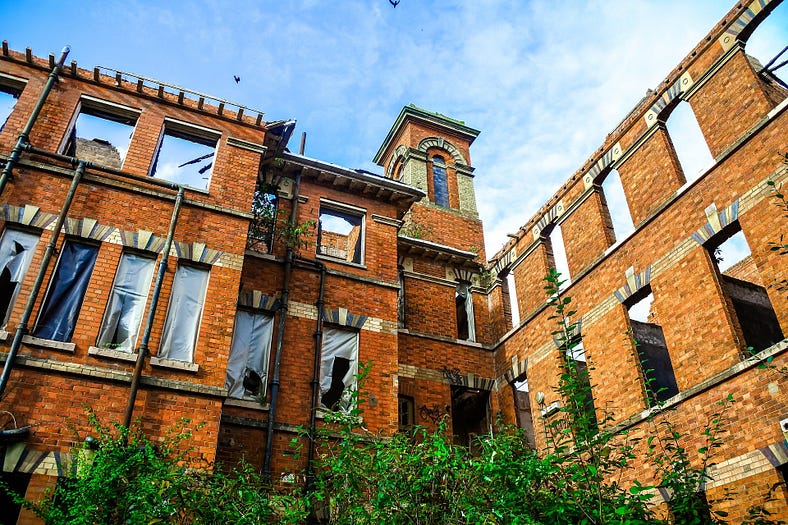
St. Crispin’s Asylum — Steven Goddard
A long time ago, as a college student, I joined friends every Wednesday evening on a journey to the nearby Northampton State Hospital. It was a historic psychiatric institution in Massachusetts originally called the Lunatic Hospital of Northampton. We were volunteers, there to talk with the patients for an hour or so. That was all. Yet decades later, because of this experience, the legacy of insane asylums still haunts me.
Northampton was an asylum for the mentally disturbed where some counseling took place, where the patients were fed and clothed but always asking us how they could leave. One woman I saw often kept telling me of visitors in silver foil who talked to her and told her secrets. Some stood against the walls staring out. I never saw family or friends visiting anyone.
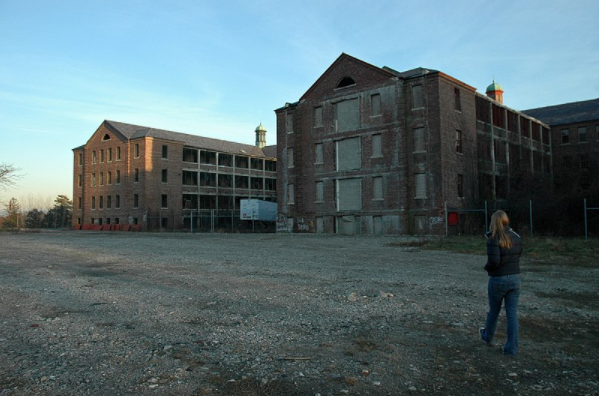
When the movie Cider House Rules came out in in 1999, I was astonished to see Michael Caine, as the doctor, walking through empty wards that were the very same ones I had visited. By then the hospital had been closed and its interiors were used for the movie, with a few outside shots of the buildings as well. It was an astonishing feeling to know he was walking where once I had done so.
We were visitors back then, and we were young, and we did not know what it was really all about. But the feeling of these people having been abandoned stayed with me. They caught at my heart.
In my book Gene Pool, published a few years ago, I describe a scene where the protagonist is walking through a cellar and winding corridors with only a dim white bulb overhead for guidance. That was exactly how we entered the Northampton buildings — I never knew why. We were not allowed through the front entrance. Remembering how we had to do that never left my imagination — a haunting memory.
The experience at Northampton has inspired a lifelong absorption in this subject. For sure, this article comes out of all of that.
Most asylums showed a special architecture, a famous design created by the renowned architect Thomas Story Kirkbride. Treatments well into the late twentieth century ranged from lobotomies and electric shock to drugs, physical abuse, solitary confinement, food deprivation. It was all so like the movie One Flew Over the Cuckoo’s Nest. Severe neglect and torture were common.
Being committed to an insane asylum was a life sentence. Inmates had no free will. They did not receive visitors. They were usually buried in the cemetery belonging to the asylum unless their bodies were donated to medical schools. Grave markers with just numbers on them are all that is left to identify these inmates. They remained unclaimed by friends or family. Many of these asylums and their cemeteries are called haunted. Little wonder!
[At the end of this article I have added source links for the information herein. These links also take you to various websites with photos and specific information about each insane asylum/state hospital, if you want to explore them further. Some have been televised for paranormal investigations and for haunted tours, as described further on.]
DANVERS STATE Insane Asylum (Danvers, Massachusetts)
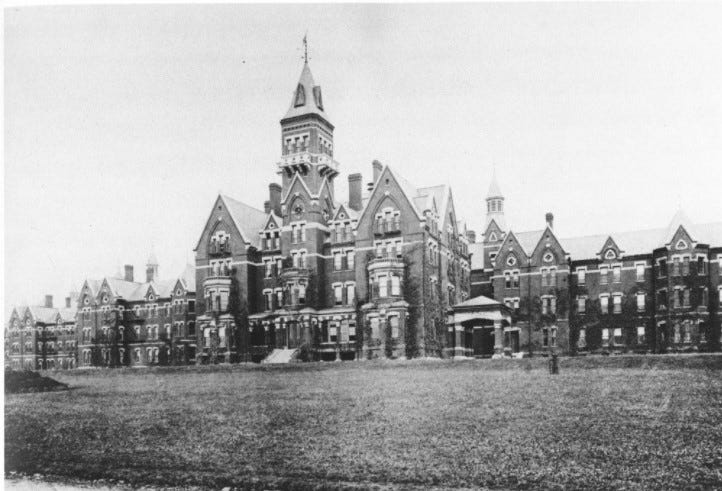
The notorious Danvers State Insane Asylum has also been called the Danvers State Hospital and the Danvers Lunatic Asylum. It was built according to Kirkbride’s design and situated over the home of Salem Witch Trial judge John Hathorne. Opening on May 1, 1878, Danvers soon overflowed with patients and not enough guards and staff. Conditions were terrible. It was also the place where a huge number of lobotomies were performed with an “ice-pick” device in the 1940s and 1950s. This operation changed patients into quiet zombies.
Such methods at Danvers served as examples for mental asylums all over the country, along with the disturbing use of electric shock therapy. Patients were admitted who showed symptoms of nervous disorders, depression, delusions, violent tendencies, senility, or whatever their family and associates determined was bad behavior.
Its cemetery is famous for glowing orbs at night and voices howling over the graves. Once overgrown and forgotten, the Danvers State Memorial Committee now maintains the site and the old, numbered markers as a testament to those who were anonymous victims.
Danvers is thought to be the source for the weird Arkham madhouse created in “The Thing on the Doorstep” by H.P. Lovecraft. For horror fans, the 2001 Session 9 film gives long shots of the exterior of the now abandoned Danvers site. It uses the interior rooms to shoot the hellish story.
STATE LUNATIC HOSPITAL AT TAUNTON (Taunton, Massachusetts)
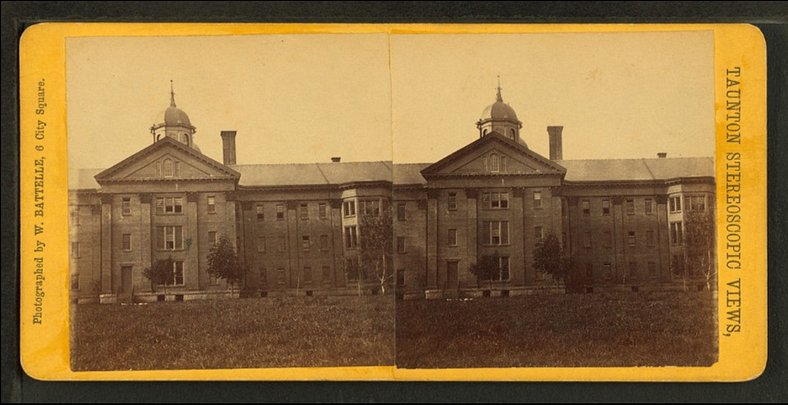
Taunton Lunatic Asylum, courtesy of Jack Schwartz
Murderer Lizzie Borden claimed she was kept in the Taunton State Hospital but she was only kept in the jail nearby. Jane Toppan, a serial killer who poisoned thirty-one people, was held in Taunton for thirty-seven years until her death. It has been called America’s most haunted asylum.
Alcoholics, people suffering from Alzheimer’s or Parkinson’s, those who had epileptic seizures, and women with post-partum depression or panic attacks or who were considered disobedient were committed to Taunton without their permission. Early on, Civil War veterans suffering from what was a form of PTSD were forced to stay there.
In the sources at the end I give a link to chilling photos and a narrative on this hospital.
To this very day the State Lunatic Hospital in Taunton has the dark weight of its past hovering about it. Mysterious hauntings continue to be reported, the voices of people screaming, handprints on the walls, and unexplained sounds. The pauper cemetery downtown is filled with broken markers where the patients from Taunton were buried, anonymous souls signified only by a number:

TRANS-ALLEGHENY LUNATIC ASYLUM (Weston, West Virginia)
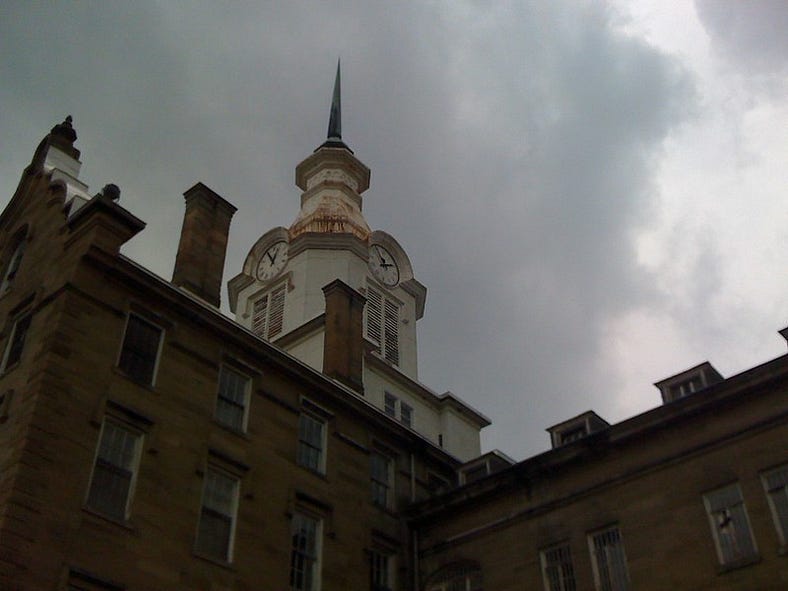
Later named the Weston State Hospital, the Trans-Allegheny Lunatic Asylum practiced lobotomies in the 1950s for the specific purpose of reducing the patient population. People with lobotomies no longer needed to be watched over because connections to and from the front of the brain had been removed with the “ice pick” method. They became passive and unable to function except for the simplest tasks. Sixty percent of the lobotomies were performed on women.
Patients were also controlled by straightjackets and bed straps. They were often kept in cribs, and as a punishment, in coffins.
The cemetery has no tombstones, just one marker in memory of all the patients buried there.
Tours are given, and paranormal events reported both inside the asylum and on the cemetery grounds.
The following programs have used the Weston State Hospital to film hauntings: SyFy’s Ghost Hunters, Travel Channel’s Ghost Adventures, and Paranormal Lockdown.
BYBERRY INSANE ASYLUM (Philadelphia State Hospital, Pennsylvania)
ByBerry was termed a house of horrors, where patients were often denied clothing and food. Charles Lord took secret photographs while he worked there that were shown to Eleanor Roosevelt, who began actions to protect asylum patients.
On May 6, 1946, LIFE Magazine published a powerful article on Byberry. The inmates experienced incredible neglect and abuse. Patients were sent there if they were alcoholics, were physically disabled or mentally ill, if they were homeless, if they were females suffering from hysteria, or if they had epilepsy. There were regular beatings, water torture, solitary confinement, chair and mouth restraints, along with the constant use of lobotomies and electric shock therapy. Startlingly, this mental hospital was not closed until 1990.
ByBerry has been reported as haunted and was studied in the paranormal television series Scared!
No death records were kept, and where inmates were buried remains a mystery. Some believe either the patients were interred in the town’s potter’s field or beneath an area now known as Benjamin Rush Park.
LETCHWORTH VILLAGE (Thiells, NY)
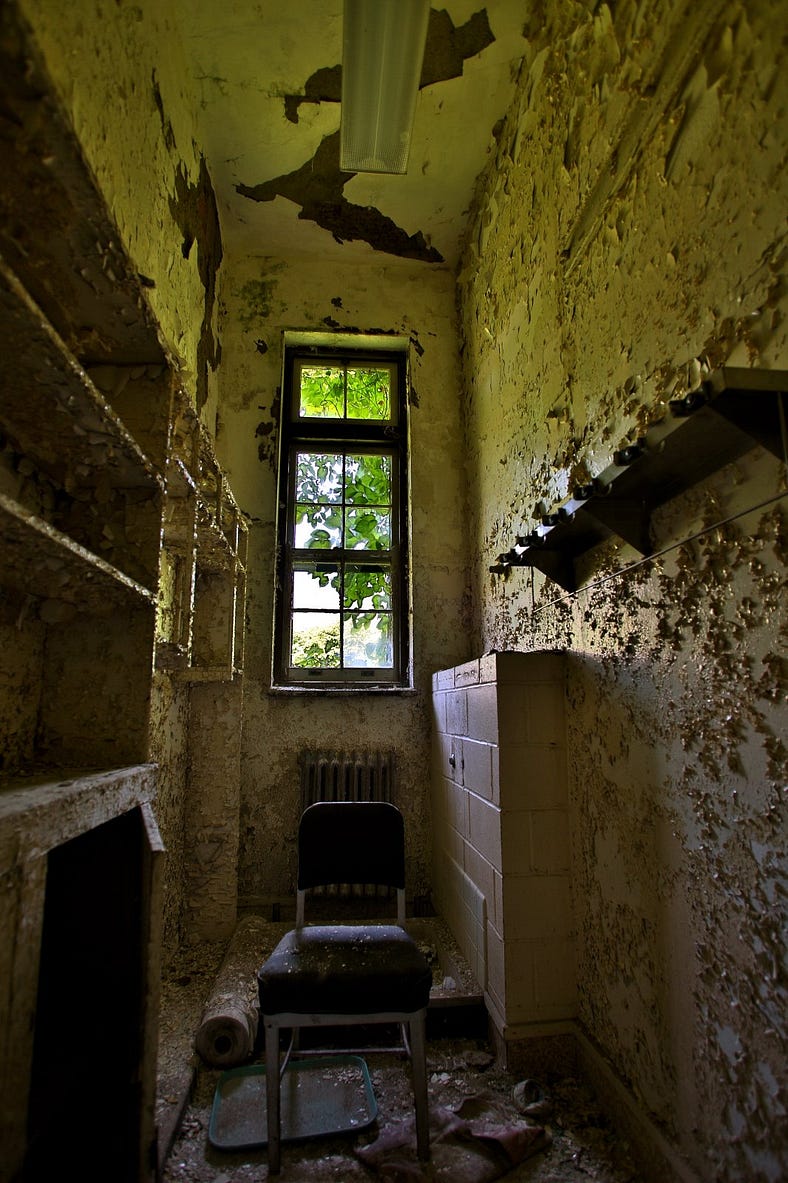
Darryl Moran
Letchworth Village was built as a mental institution intended for a small population. Over time, it expanded to three times its capacity — 4,000 patients by the 1940s. It gave four categories for those to be admitted: the “feebleminded,” the morons,” the “imbeciles,” and the “idiots.” All the children in the Village were used as test subjects, most famously for the polio vaccine, making Letchworth the site of one of the first human trials in the world. There were no family or friends consulted for permission to perform this testing. The brains of patients who died at Letchworth were often removed and used for lab study.
Old Letchworth Village Cemetery contains markers signifying the nine hundred patients buried in it. A plaque is installed on which is written an epitaph: “To Those Who Shall Not Be Forgotten”.
MEDFIELD INSANE ASYLUM (Medfield, Massachusetts)

Patients at Medfield came from many walks of life, from blacksmiths and shovel makers to hatmakers and farmers. In 1898, the asylum had one hundred ten women committed and only thirty-five men. Half the women were termed “hysterical” housewives and maids. Medfield had no children’s wards, which required the child population to live with the adult population. The effects of this were often dire for children and staff alike. In addition, patients were not often supervised, which meant many of them would leave the hospital grounds. They would walk around downtown Medfield or wander through the parks. This was an issue that went on for decades, with 126 patients reported missing in 1981.
Medfield sent the bodies of patients to Harvard University for study and dissection by students in medical programs. Massachusetts law required the body parts to be returned to Medfield afterwards for burial. The Medfield Insane Asylum cemetery was built in Vine Lake Cemetery in a specified lot. An unusual effort was made by the Medfield town community to identify the eight hundred patients, matching each number with name, birth, and death records that had been stored.
The site was used in the film “Shutter Island,” based on the Dennis Lehane novel of the same name.
PENNHURST INSANE ASYLUM (Spring City, Pennsylvania)
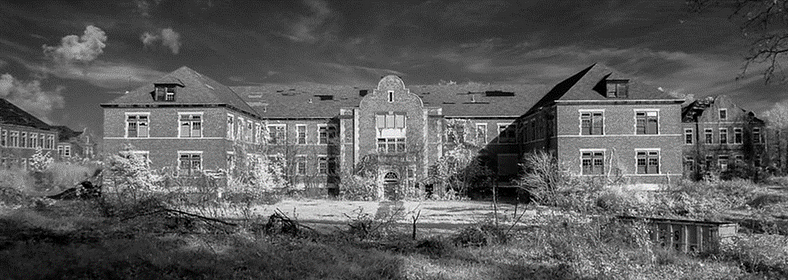
Pennhurst, by Thomas James Caldwell
At one time, Pennhurst Asylum managed over 10,000 patients. It was intended as a state school but frequently condemned for its inhumane methods and abuse of the patients. Those admitted to Pennhurst were categorized as defective people, including the mute, deaf, and blind, as well as those who had offensive habits or problems speaking. Patients were abused by nurses and staff on a regular basis, deprived of basic human needs and care. Thousands of mentally disabled children were left by parents. The buildings abandoned when Pennhurst was shut down in 1987 held patient belongings and medical records that were never collected or retrieved. They are still scattered through the rooms, subject to rain and snow. Pennhurst was called “The Shame of Pennsylvania.” Its dark legacy finally led to sweeping reforms in the running (and closing) of insane asylums and state hospitals everywhere in the U.S.
The graves of the nine hundred children kept in Pennhurst fill the cemetery.
ATHENS HOSPITAL FOR THE INSANE (Athens, Ohio)
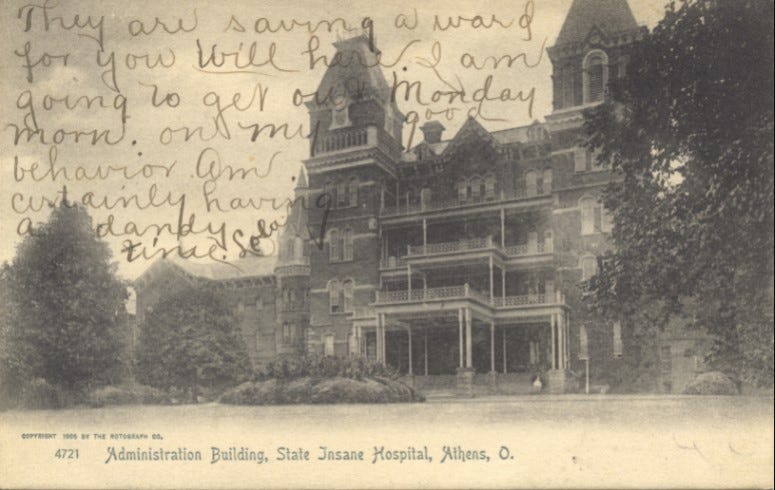
This postcard is chilling with its opening line: “They are saving a ward for you.”
This hospital was first named Athens Lunatic Asylum in 1874. It is now used for another purpose entirely. It is called Ridges and lies on the Ohio University campus. A sad exhibit in Ridges now shows a violin created by a patient named “John.” A pick that was used to perform as many as twenty lobotomies a day is also shown, along with an antique device used for electroshock. Athens also excelled in the use of psychotropic drugs on patients.
At least 1800 patients were buried on the grounds of the hospital. The cemetery had only numbered posts. This time, however, the names of the dead had been kept in ledgers. An effort was successfully made to identify some of the remains. One register still exists which gives the names of 1700 people out of nearly 2,000 burials. Visitors claim they have seen ghostly figures and bizarre lights in the cemetery. One area contains a circle strangely made up of linear gravestones.
ROLLING HILLS ASYLUM (East Bethany, New York)
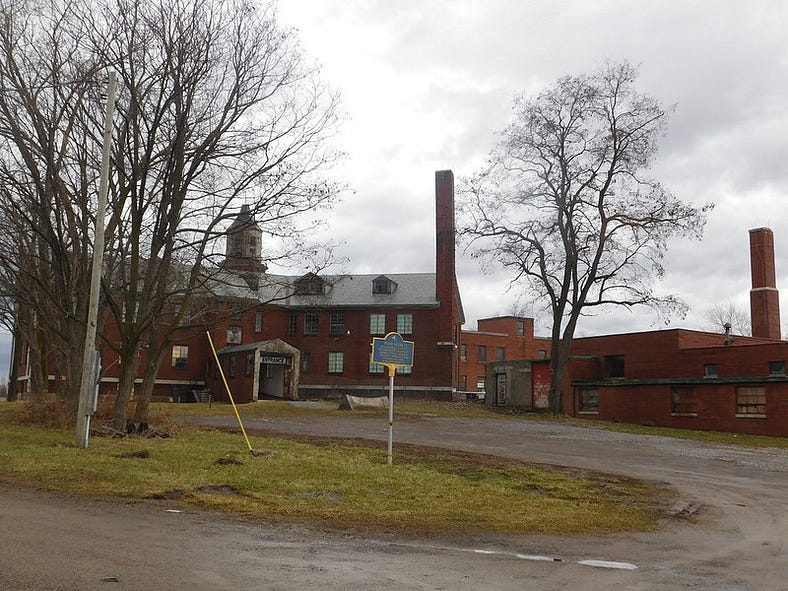
Genesee County built its asylum in East Bethany, NY in 1828 to hold lunatics and the poor. A husband could have his wife locked up for not obeying him. Solitary confinement and torture were used as punishments. Orphaned children, the mentally handicapped, drunkards, the elderly, those physically disabled, and people with Tourette’s syndrome were committed to the asylum. One inmate was abandoned at age twelve by his father at Rolling Hills Asylum because he had gigantism, which means he grew to seven and a half feet. He remained there until his death at age sixty-two.
The “Haunted North America” television program indicates the Rolling Hills Asylum to be the sixth most haunted site in the United States. (Pennhurst is rated #1 and Trans-Alleghany #3.) A viable cemetery for patients once existed on the grounds but gradually over time the stone markers crumbled and the cemetery fell to ruin and was overgrown. There are reports, however, that the morgue inside the asylum is haunted.
WILLARD ASYLUM FOR THE CHRONIC INSANE (Ovid, New York)

Public Domain
Though it is now a prison, tours are still given to view the site of Willard Asylum for the Chronic Insane on the shores of Seneca Lake, NY. A New York surgeon founded the asylum in hopes of protecting people who were “demented and deformed” in some way. Families confronted by a mentally ill member were deeply ashamed and wanted them out of sight. One patient admitted was a girl who had been kept chained to a cell since early childhood and another was left on the steps in a chicken crate.
When the patients died, their possessions were put in the attic in suitcases. There are sad photos of what was left in those suitcases of patients who thought they were only going to stay awhile. They had no idea they would stay for their lifetime. The cemetery on the grounds holds only markers for those patients who were not consigned, unnamed, to the asylum’s crematorium. Volunteer genealogists have amazingly discovered some records to identify those who were interred in the fields.
Thoughts
It is hard to acknowledge the tragic consignment of so many people to what could be described as a living death, bereft of the presence of human loving kindness around them and denied any help at all.
God bless those wretched ones who were forced to live their short or long lives in the asylums that were intentionally created by medical men and architects — people who believed they were providing a service to those in need. Instead, they opened Pandora’s box.
This was compounded when the Federal government, by order of the then-president Ronald Reagan, closed all the state hospitals nationwide. No follow-up care was offered for the patients. They were sent out into the streets and left to fend for themselves. Very, very few of them had the capacity to do that. They, most of them, had only the streets to live on, and no capacity to take on a normal job. They literally had nowhere to go, and their presence overwhelmed what Help agencies and services there were.
We are still grappling with the question first raised in the book of Genesis — “Am I my brother’s keeper?”
The answer is, of course, YES. We are each of us keepers of one another, sisters and brothers in spirit and in form. Would that we find a way to trust and live that out.
Source Links
Danvers
Danvers State Hospital, Danvers, Massachusetts, Kirkbride Complex, circa 1893.jpg — Wikimedia Commons. See also: Kirkbride, T.S. (1854). On the construction, organization, and general arrangements of hospitals for the insane. Philadelphia, PA: (n.p.).]
https://allthatsinteresting.com/danvers-state-hospital
https://www.atlasobscura.com/articles/americas-abandoned-insane-asylum-cemeteries
http://newenglandfolklore.blogspot.com/2012/07/danvers-state-hospital-cemetery.html
https://www.hplovecraft.com/writings/texts/fiction/td.aspx
https://www.imdb.com/title/tt0261983/
Taunton State Hospital
https://www.newbedfordguide.com/the-lunatics-mentally-ill-and-ghosts-of-the-state-lunatic-hospital-in-taunton/2018/10/30/3
Tangled Trees: Taunton State Hospital Pauper Cemetery Markers
http://www.ghostsofnorthamerica.com/taunton-state-hospital/
https://www.abandonedamerica.us/taunton-state-hospital
Trans-Allegheny Lunatic Asylum
The Horrifying History Of The Trans-Allegheny Lunatic Asylum (allthatsinteresting.com
https://researchrepository.wvu.edu/cgi/viewcontent.cgi?article=1860&context=etd
Weston State Hospital Cemetery in Weston, West Virginia — Find A Grave Cemetery
Byberry Asylum (Philadelphia State Hospital)
https://www.npr.org/templates/story/story.php?storyId=122017757
https://pabook.libraries.psu.edu/literary-cultural-heritage-map-pa/feature-articles/best-intentions-byberry-asylum
https://www.imdb.com/title/tt1452177/ (Actual Scared! documentary)
The Story of Byberry (philadelphiastatehospital.com)
Letchworth Mental Hospital
Inside Abandoned Letchworth Village, a Former Mental Institution in Rockland County NY — Untapped New York (untappedcities.com)
https://abandonednyc.com/2012/08/05/legend-tripping-in-letchworth-village/
https://www.atlasobscura.com/articles/americas-abandoned-insane-asylum-cemeteries
Medfield State Hospital
https://medfield.wickedlocal.com/news/20160731/medfield-state-hospital-1897-to-today
https://www.abandonedspaces.com/hospital/medfield-state-hospital-the-filming-location-of-both-shutter-island-and-the-box.html
https://harvardartmuseums.org/art/313685
Medfield’s Abandoned Insane Asylum — Locations of Lore
Pennhurst Asylum
Pennhurst Asylum: The Shame of Pennsylvania | Weird NJ
Tragic Photos Inside America’s Most Horrific Abandoned Asylum (thevintagenews.com)
A Living Nightmare: The History of Pennhurst Asylum (the-line-up.com)
https://www.findagrave.com/cemetery/2302420/pennhurst-memorial-cemetery
Athens Asylum for the Insane
Haunted Athens Asylum for the Insane, Ohio — Legends of America
The Athens Asylum Was at the Forefront of Treatment in the 19th Century | The National Endowment for the Humanities (neh.gov)
America’s Abandoned Insane Asylum Cemeteries — Atlas Obscura
Rolling Hills Asylum
The History — Rolling Hills Asylum
Rolling Hills’ Haunted History | Travel Channel’s Ghost Adventures | Travel Channel
Rolling Hills Asylum (hauntedhistorytrail.com)
Rolling Hills Asylum — NY Ghosts
Willard Asylum for the Chronic Insane
An Inside Tour of ‘Willard Asylum for the Chronic Insane’ — Ovid, NY
There’s Something Truly Terrifying About This Abandoned Insane Asylum
Willard State Hospital — Asylum Projects
The chilling pictures of suitcases left in a New York insane asylum by patients who were locked away for the rest of their lives | Daily Mail Online
Willard Asylum: One Of The Creepiest Places In America
The Anonymous Burial Ground | The Inmates of Willard 1870 to 1900 / A Genealogy Resource
- I’m so glad you are here and thank you for reading…

